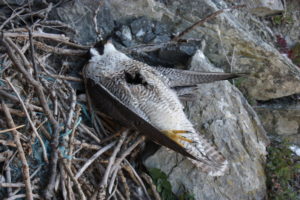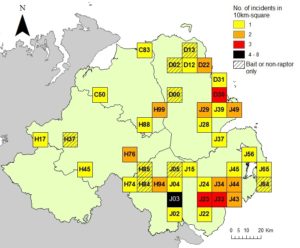Bird of prey killing widespread across Northern Ireland – Birds of prey victims of 11 incidents of wildlife crime recorded in two years-just the tip of the iceberg?
57 birds of prey were confirmed victims of reckless or intentional criminal activity in Northern Ireland during the last eight years. The latest report detailing the illegal killing of Northern Ireland’s native birds of prey has been published by the Partnership for Action against Wildlife Crime (PAW NI) and is available www.wildlifecrimeni.org. It reveals that there were five confirmed illegal poisoning or persecution incidents in 2015 and a further six in 2016, involving the killing of 12 protected birds of prey in Northern Ireland during this period. Killing six buzzards, five peregrines and one sparrowhawk.

The report lead author, Dr Eimear Rooney (Raptor Officer for NIRSG) commented: “This latest persecution report helps us all to understand the scale and distribution of the problem. It is particularly shocking to see new areas appear on the hot-spot maps, showing the issue of raptor persecution to be widespread. It is heart-breaking to think of the deaths of these protected birds but it is particularly shocking to see the continued usage of highly toxic Carbofuran. The PAW NI group will continue to take action to tackle raptor persecution and it is encouraging to see all the partners proactively working together on this report.”
In 2015/2016 three of the incidents involved the use of the pesticide Carbofuran, which has been banned across the EU since 2001. This poison is illegal to use cross Europe due to its high toxicity to wildlife and humans. Further birds were killed using other banned pesticides, restricted-use rodenticides and the remainder were illegally shot.
Superintendent Brian Kee, PSNI service lead for rural and wildlife crime, added: “Wildlife crime, including the illegal killing/poisoning of birds of prey, is taken extremely seriously by Police. It isn’t acceptable for birds of prey or any other wildlife to be killed in this way. These actions are illegal and the use of toxic poisons is indiscriminate as they put children, pets and livestock at risk too. We would urge anyone who has information about any incident of poisoning to come forward by calling Police on the non-emergency number 101. Or information about crime can be passed to the Crimestoppers charity anonymously on 0800 555 111.”
There were 49 cases of suspected wildlife crime involving birds of prey reported to the PSNI in 2015 & 2016, some of the birds were shown to have died naturally (e.g. disease, starvation/ collision) and many of the birds were too decomposed for accurate testing. Twenty birds tested positive for the consumption of rat poisons, a reminder to landowners to use rodenticides in a responsible manner to minimise the likelihood of exposure to non-target wildlife and pets. Users must always read and adhere to the label instructions of the rodenticide, and they should collect and correctly dispose of any rodent carcasses daily. 
The report examines the occurrence and trends in confirmed persecution incidents of these birds, which has allowed PAW to produce ‘hot-spot’ maps to identify areas where crimes against birds of prey are occurring. Of the 11 confirmed cases in 2015 & 2016, five occurred in County Antrim, two in Counties Down and Armagh and one in each of counties Londonderry and Tyrone.
The report shows that, since 2009, the most frequent casualties have been buzzards, peregrine falcons, and the recently re-introduced red kite. Red kites and buzzards are particularly susceptible to poisoned baits as they will scavenge on carrion routinely.
Eimear Rooney added that, “where members of the public come across a dead or injured bird of prey and there is no obvious innocent explanation for its injuries, such as contact with power lines or windows, and a crime is suspected then they should call the PSNI on Tel: 101.
If the bird(s) are found close to a suspicious bait, keep people, pets and livestock away until the police arrive. This report only covers the carcasses that are recovered and it is likely the ‘tip of the iceberg’, as these incidents tend to occur in remote locations. Therefore keep your eyes open in the countryside and remember timely reporting is important”.
The report is available to download at here from the Watch Out for Wildlife Crime website
• PRESS POINT OF CONTACT: please contact Dr Eimear Rooney; raptorofficerni@gmail.com; 07743068931.
Notes to editor:
• Raptor (or Bird of prey) Persecution is one of the UK Government’s top six Wildlife Crime priorities. Raptor crimes typically comprise illegal shooting, trapping or poisoning events and may occur at any time of the year. It is also illegal to cause disturbance to all breeding raptors or damage their nests or eggs.
• The Raptor Priority Subgroup comprises Police Service of Northern Ireland (PSNI); Northern Ireland Environment Agency (NIEA); National Wildlife Crime Unit (NWCU); Northern Ireland Raptor Study Group (NIRSG); the Royal Society for Protection of Birds (RSPB); Agri-food and Biosciences Institute (AFBI) and the Health and Safety Executive for Northern Ireland (HSE NI). The Raptor Priority Sub-Group is acting on behalf of, and reports back to, the main PAWNI steering group, currently chaired by the PSNI.
• More information on the public campaign to ‘Watch Out For Wildlife Crime’ in Northern Ireland can be found at www.wildlifecrimeni.org
• Wildlife legislation, namely the Wildlife (Northern Ireland) Order 1985 as amended by the Wildlife and Natural Environment (NI) Act 2011, protects birds of prey from disturbance and/or destruction by special penalties. Penalties can include a custodial sentence and/or up to a £5,000 fine per offence. All raptors are listed on Schedule 1 of the order and there are six raptor species which receive additional protection on Schedule A1 which protects their nests from disturbance or destruction at all times of the year. Schedule A1 includes peregrine falcon, red kite, barn owl, golden eagle white-tailed eagle and osprey.
• In March 2016 the PSNI, in partnership with the PAWNI Raptor Subgroup members, launched ‘Operation Raptor’. This campaign was developed as a direct result of the publication of the first Bird of Prey Persecution and Poisoning Report, covering the period 2009 – 2013. The ‘Operation Raptor’ campaign is designed to encourage people to report potential crimes to PSNI and also to warn offenders they could face a custodial sentence and/or a fine (up to £5,000 per offence) if they are caught targeting birds of prey through poisoning, shooting or trapping. Operation Raptor posters are being distributed into ‘hot spot’ areas to highlight the illegal practises to local members if the public, to act as a deterrent to those who seek to kill birds of prey.
• The Campaign for Responsible Rodenticide Use (CRRU) aims to promote best practice so that rat poisons (rodenticides) in particular should not get into the wildlife food chain where it harms owls, kites and other birds of prey. More information on this can be found at www.thinkwildlife.org
• A leaflet outlining the protocol for reporting raptor crimes was previously produced by the Raptor Subgroup and is available for download at the following link: https://www.nirsg.com/wp-content/uploads/2014/02/PAWNI-Raptor-Crime-Leaflet.pdf
• The Bird of Prey Persecution and Poisoning Report 2009-2013, and The Bird of Prey Persecution and Poisoning Report 2014, both previously produced by the Raptor Subgroup in November 2015 and November 2016 respectively, can be downloaded at the following links:
https://www.psni.police.uk/globalassets/advice–information/animal-welfare/documents/pawni-raptorpersecution–poisoning-report-2009-2013-final.pdf
https://www.psni.police.uk/globalassets/news-and-appeals/latest-news/news-stories/2016/november/25112016-ni-raptor-deaths-rise-new-report-reveals/2-paw-rs-persecution-report-2014_final.pdf
• More information on the Wildlife Incident Investigation Scheme (WIIS) is available at: http://www.hse.gov.uk/pesticides/topics/reducing-environmental-impact/wildlife.htm